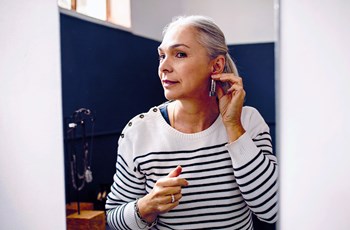
When shopping for jewelry, do you consider what metals make up earrings, bracelets, rings, and other shiny items? A report by the Center for Environmental Health (CEH) in California detailed that cadmium was present in numerous jewelry items tested from stores including Ross, Walgreens and Nordstrom Rack [1]. The amount of cadmium, a toxic heavy metal, ranged from 40-100% in the items testing positive.
Is Cadmium Allowed in Jewelry?
Surprisingly, there are no restrictions on the amount of cadmium allowed in adult jewelry in the United States. There is a limit of 0.03% cadmium in children’s jewelry in California, a result of a settlement in 2011, after it was found at high levels in jewelry marketed toward pre-teens [2]. Children are more likely to be exposed to cadmium in jewelry as they might swallow or chew on the metal pieces. The European Commission banned cadmium in all jewelry sold in Europe starting in 2011 [3].
Why is Cadmium in Jewelry?
At some point cadmium became a popular replacement for lead in jewelry, likely due to an increase in lead restrictions. Cadmium is used to add mass and weight to jewelry and can add a shiny finish. Cadmium has a lower melting point than metals such as zinc, reducing the energy required to melt it into shape.
The Agency for Toxic Substances and Disease Registry (ATSDR) lists cadmium as the number 7 most significant threat to human health |
Why is Cadmium Dangerous?
Cadmium is a dangerous heavy metal and a known carcinogen [4]. The Agency for Toxic Substances and Disease Registry (ATSDR) lists cadmium as the number 7 most significant threat to human health, based on its frequency, toxicity, and potential for human exposure [5]. Cadmium has a half life in the body around 10-30 years, meaning that a single exposure event can stick around for nearly a lifetime. As we age, cadmium body burden slowly increases. Cadmium primarily targets kidneys and bones, but can also be detrimental to reproductive health. Although inhalation is the most dangerous route of exposure (10-50% absorption), ingestion (2.5-5% absorption) and dermal (0.5% absorption) exposure are also dangerous, especially at high concentrations [6].
How do I Protect Myself?
There is no simple way to tell if jewelry contains cadmium or not just by looking at it. Buying jewelry that is made locally or its metal content verified by the retailer can reduce the risk of cadmium exposure. Non-metal decorative items such as ceramic, leather, plastic, or fiber can be worn instead. ZRT Laboratory offers two ways to test for exposure to cadmium. Whole blood cadmium is the best indicator of recent exposure (months), while urine cadmium is the best indicator of long term exposure (years). Overall, it is best to avoid any exposure to cadmium, as it will surely stick around for a long period of time.
Related Resources
- Blog: Are Heavy Metals in Lipstick Making Us Sick?
- Blog: Cadmium's Connection to Infertility and Reproduction
- Get Started with our Heavy Metals & Essential Elements testing
References
[1] https://www.ceh.org/news-events/press-coverage/content/ap-exclusive-toxic-metal-found-chain-stores-jewelry/
[2] https://www.ceh.org/legacy/storage/documents/cadmium_report_2_2010.pdf
[3] http://europa.eu/rapid/press-release_IP-11-620_en.htm
[4] https://www.atsdr.cdc.gov/phs/phs.asp?id=46&tid=15
